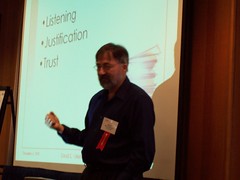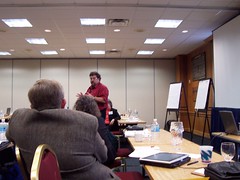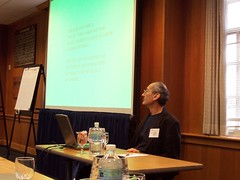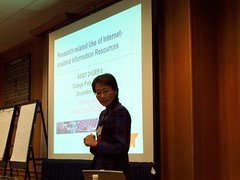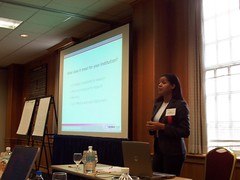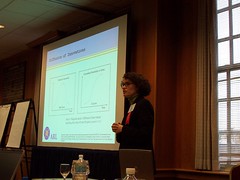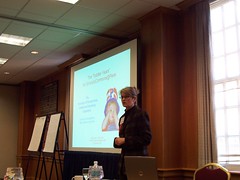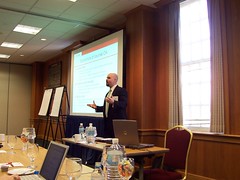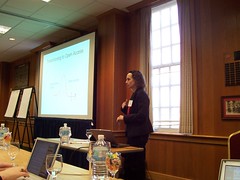Tim Hays, NIH: NIH Public Access Policy
Mood:
 caffeinated
caffeinated
Notes by Christina Pikas

Announced in Feb, implemented in May. In
PubMed Central
Goals
- archive of NIH research
- advance science
- access to the public
Driving Forces included Congress, new IT, increasing public use of the internet
56% of internet users bring documents with them when they visit the doctor's office (?!?)
Internal drivers: need archive to study the outcomes of funding efforts, make information available that they paid for on the public's behalf
The policy:
-0-12 month embargo
-peer-reviewed, original research publications, supported in whole or in with direct costs from NIH. Not book chapters, editorials, review, or conference proceedings.
-currently funded (or if accepted for publication after May..)
-does not affect copyright
-authors are encouraged to add a line to their publication agreement that says that they will submit to NIH
-should not effect peer review
-should not affect scientific publishing (1% journals in pubmed have more than 50% of their articles funded by NIH, 10% of the articles in pubmed were funded by NIH)
-has had some positive effect with journals now having a self-archiving policy
(audience comment that Nature is backsliding from 0 month self-archiving to 6 month self-archiving)
Timeline
Final policy 2/3/2005
System released 5/05
New website 10/05
by Feb/06 hope to have a batch upload function (they're working with Elsevier, Wiley, Nature)
Participation
About 2% to 3% (not including the 8% from PubMedCentral journals that are in there by default) as SH said this 10% mirrors the participation world-wide in self-archiving with no policy (or TLC from a librarian :) )
Delay/embargo
- about 60% immediate pub, 20% after 9-12 months
- Have removed 40 articles because of too early publication (from about 10 journals)
Issues with researchers who want/need to get published, but worry that the copyright negotiations may delay or prevent paper acceptance, plus figuring out funder policy, their institution policy...
NIH is doing outreach
Public Policy Working Group (11/15/2005)
Limited survey of 19 health sciences libraries... 87% of faculty were aware of the policy, 4% had submitted
Largest factors
-time
-priority
-confusion over copyright and version
Q from audience:
-make mandatory (this is being considered, but somewhat difficult because part of the regulatory process, also Dr. Zerhouni saw this as a way of changing the landscape -- did not want to cause bad will with groups with whom NIH cooperates)
-group doesn't include open access publishers
Working with publishers
-3rd party submissions
-Elsevier, Nature, Wiley submit directly (they control version, embargo)
-software tool for offline verification of grant numbers
-will post the publisher version over the author version, place links to the publisher site, correct author errors, place links to article correction notificationon the publishers web site
-will have xml and pdfs of all documents
Questions to the working group
1) should participation be mandatory - 12 out of 14 yes (two who said no, Elsevier (no, really?) and FASEB)
2) what should be the embargo?
A variety, many said 6months
3) what is the best version
publisher version, but not clear on whether xml or pdf
Next steps
-continue outreach
-evaluate
-batch uploading
-report to congress
From the audience:
sh: "flawed policy that missed historic opportunity... but can be improved" flaws: voluntary, let the word embargo be said, demand central deposit
should have done: request that the depost be made either in own IR or in PMC, then PMC can harvest automatically from IRs. make it into an instant deposit upon acceptance. build into metadata that shows up immediately - with e-mail to author to request e-print. NIH should also offer to pay reasonable publishing in open access
From Jan V: springer is not on committee, but should be mandatory, no embargo, both xml and pdf, explicitly say on the NIH page that it is OK for open access publishing to be covered by grants (Wellcome trust does this).
From Brad: mandatory is the important thing
From Mary: mandatory needs to happen that will really be transformative
From Paige: impact to publishers... what would it be if all of the large science funders in government (DOD, NASA, ... ) did this
From Peiling: theoretically mandatory is necessary, but getting the regulations in place is a long term thing... what if all new grants from this point forward have that requirement?
Vivian: meeting of publishers hosted by Blackwell where everyone got up and said how horrible this is... unnecessary duplication of what highwire pubs etc are doing...
Is there an analysis that shows if people can get to things that they would not have been able to get to otherwise... IOW, does it really make things available that aren't elsewhere available?
Answer: not enough content, plan to evaluate....
daser2005Updated: 12/5 to add tag and picture
Posted by asistdaser
at 10:50 AM EST
Updated: Monday, 5 December 2005 12:43 PM EST


